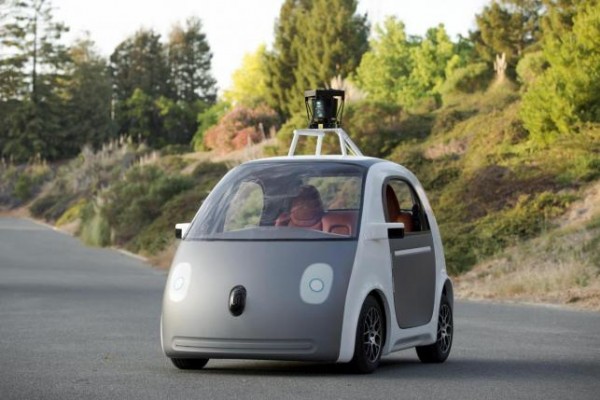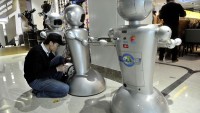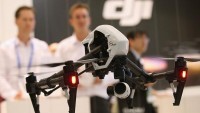Self-Driving Vehicles: Can Machines Respond to Situations Like Humans Behind the Wheel?
| Sami Ghanmi | | May 02, 2016 06:33 AM EDT |
(Photo : Reuters) A prototype self-driving car by Google is shown in this publicity photo released to Reuters June 27, 2014.
In the field of Artificial Intelligence (AI), researchers and experts are constantly turning towards the example of the natural world, especially the human model, as a means to develop new computer systems that will enable sophisticated machines to behave intelligently and navigate through an environment.
Like Us on Facebook
In order for a machine to navigate through an environment, it needs to have the ability to "see" and recognize objects in the real world. It needs a "computer vision" system.
In the autonomous vehicle world, computer vision systems are also among the technologies that allow self-driving vehicles to sense the environment, detect objects on the road, avoid collision, and identify obstacles and appropriate navigation paths. In fact, current visual systems or image-recognition technologies in self-driving cars can allow machines to develop the ability to "learn to respond to new situations" like how human beings would, according to researchers from the University of Leuven (KU Leuven) in Belgium.
Researcher Jonas Kubilius explains, "Current state-of-the-art image-recognition technologies are taught to recognize a fixed set of objects. They recognize images using deep neural networks: complex algorithms that perform computations somewhat similarly to the neurons in the human brain."
"We found that deep neural networks are not only good at making objective decisions ('this is a car'), but also develop human-level sensitivities to object shape ('this looks like ...'). In other words, machines can learn to tell us what a new shape -- say, a letter from a novel alphabet or a blurred object on the road -- reminds them of. This means we're on the right track in developing machines with a visual system and vocabulary as flexible and versatile as ours."
According to Mr. Kubilius, this does not mean that machines will soon be able to take over the wheel. He said, "We're not there just yet. And even if machines will at some point be equipped with a visual system as powerful as ours, self-driving cars would still make occasional mistakes -- although, unlike human drivers, they wouldn't be distracted because they're tired or busy texting."
In addition to autonomous vehicles, computer vision is being used in other areas such as robotics, drone technology, industrial robotics for controlling processes, manufacturing, medical image processing, visual surveillance, and for computer-human interaction.
In drone technology, researchers from the Department of Biology at the Lund University (LU) in Sweden have turned to the workings of insects to develop a new vision system that will allow drones to navigate through complex environments independently. This new system, on the other hand, mimics the visual perception of insects such as bees. It was inspired by the study of how the green orchid bee, also known as Euglossa dilemma, assesses the intensity of light in order to navigate its way through the dense forest.
TagsArtificial Intelligence AI, Computer Vision System Machine, Self-Driving Vehicle Autonomous Cars, Computer Vision Recognize Objects, Image-Recognition Technology, AI Neural Network, Human Machine
©2015 Chinatopix All rights reserved. Do not reproduce without permission
EDITOR'S PICKS
-

Did the Trump administration just announce plans for a trade war with ‘hostile’ China and Russia?
-

US Senate passes Taiwan travel bill slammed by China
-

As Yan Sihong’s family grieves, here are other Chinese students who went missing abroad. Some have never been found
-

Beijing blasts Western critics who ‘smear China’ with the term sharp power
-

China Envoy Seeks to Defuse Tensions With U.S. as a Trade War Brews
-

Singapore's Deputy PM Provides Bitcoin Vote of Confidence Amid China's Blanket Bans
-

China warns investors over risks in overseas virtual currency trading
-

Chinese government most trustworthy: survey
-

Kashima Antlers On Course For Back-To-Back Titles
MOST POPULAR
LATEST NEWS
Zhou Yongkang: China's Former Security Chief Sentenced to Life in Prison

China's former Chief of the Ministry of Public Security, Zhou Yongkang, has been given a life sentence after he was found guilty of abusing his office, bribery and deliberately ... Full Article
TRENDING STORY

China Pork Prices Expected to Stabilize As The Supplies Recover

Elephone P9000 Smartphone is now on Sale on Amazon India

There's a Big Chance Cliffhangers Won't Still Be Resolved When Grey's Anatomy Season 13 Returns

Supreme Court Ruled on Samsung vs Apple Dispute for Patent Infringement

Microsoft Surface Pro 5 Rumors and Release Date: What is the Latest?













